Photography is an art that has the power to freeze time, capturing fleeting moments that can never be replicated. One of the key elements that can elevate your photography skills is exposure. Understanding and mastering exposure can transform the way you take photos, enabling you to convey emotions and tell stories through your lens.
Every photo you capture can tell a story, and the way light interacts with your camera’s sensor can make all the difference. Exposure fundamentally refers to the amount of light that reaches your camera’s sensor, affecting the brightness and overall quality of the image. It’s essential to understand that exposure isn’t just about making a photo lighter or darker; it can also influence the mood and tone of your shots.
When you think about the optics of your camera, it’s easy to get overwhelmed by the numbers. However, focusing on the basics of exposure can open up a whole new dimension in your photography journey. The three components that can greatly affect exposure are aperture, shutter speed, and ISO. Each of these elements plays a critical role in how light is captured, and adjusting them can yield dramatically different results.
For instance, when you open up your aperture (the ‘f-stop’), you allow more light to enter the camera, which can create a beautiful depth of field, blurring the background and focusing on your subject. Conversely, if you’re shooting in bright light, a smaller aperture can help prevent overexposure. This balance can significantly impact how your photos look and feel.
Shutter speed is another crucial aspect of exposure. It determines how long your camera’s sensor is exposed to light. Faster shutter speeds can freeze fast-moving subjects, capturing sharp images of action, a technique that can be particularly beneficial in sports or wildlife photography. On the other hand, slower shutter speeds can create artistic effects, such as the soft blur of flowing water, which adds emotion and movement to your photography.
ISO is the final piece of the exposure triangle. It measures your camera sensor’s sensitivity to light. A low ISO is ideal for bright conditions, helping to maintain image quality without introducing grain. However, when shooting in low-light situations, increasing the ISO can be essential, offering the ability to capture moments that would otherwise be lost in darkness. But remember, too high of an ISO can introduce noise, potentially detracting from the overall quality of your shot.
Mastering exposure can truly be the difference between an average photo and a stunning masterpiece. It allows you to express your vision, convey emotions, and draw viewers into the world you’ve captured. The beauty of photography lies in its power to connect with others, evoking feelings and narratives through each picture you take. When you expand your understanding of exposure, you can actively create the images you envision, making every shot count.
In the end, it’s essential to remember that practice makes perfect. Don’t be afraid to experiment with exposure settings on your camera. Each attempt, whether successful or not, will bring you one step closer to capturing the perfect moment. So grab your camera, head out, and let the light inspire you as you hone your skills in the captivating world of photography.



